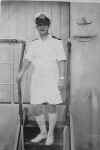Back to Military Service
These are some of the exploits of Lieutenant Albert Halewood Brew, who served on HM Australian Ships Manoora, Doomba, Bundaberg
and Lachlan, as
a member of the RANVR, in the Pacific Theatre during the Second World War.
 |
Albert H. Brew was mobilised on the 19 June 1940 and assigned as a "Probationary Engineer Lieutenant (Temporary)" to
the 10,900-ton Armed Merchant Cruiser HMAS Manoora. Originally MV Manoora, built in Glasgow in 1935, she was commissioned
HMAS Manoora in December 1939. She was refitted for wartime service and carried
out patrols initially in Australian waters. Between December 1940 and September 1941, Manoora
patrolled and took part in escort operations in an area bounded by the Australian East
Coast to Darwin, Thursday Island, Nauru, Ocean Island, the Solomon Islands, New Guinea,
and New Britain.
|
| . |
| By December 1941, the "Probationary" and "Temporary" had been
dropped from Albert's title, and he was now "Engineer Lieutenant RANVR". In
that same month, Manoora carried the Chief of Naval Staff, Admiral Sir Guy Royal,
Royal Navy, and his staff to Singapore. Albert was in Singapore on Manoora
on the day Japan entered the war. |
 |
Japan made an air attack on Singapore on the same day
she attacked Pearl Harbour, 7 December 1941, except that because of the time difference,
Singapore was actually attacked earlier. Manoora managed to escape undamaged and
made for the open ocean, heading for Calcutta. She spent the remainder of 1941 and
the first few months of 1942 escorting convoys in the Bay of Bengal. On 1 March 1942, Manoora
sailed from Colombo to Australia with a convoy carrying over 10,000 troops returning from
the Middle East.
In mid-1942, she entered Garden Island Naval Dockyard, in Sydney harbour, for
conversion to a Landing Ship. At this point Albert transferred to HMAS Doomba, taking up his post on 22 July 1942
 |
Doomba had just been refitted as an anti-submarine vessel in
Sydney, where Albert joined her, and became part of an escort force operating out of
Melbourne. Albert's wife, Iris, and their two boys, John, 4, and Alan, 9 months, moved to
Melbourne in September. Albert was away for a week or so at a time when the ship escorted
convoys, which was a fairly hazardous job owing to the amount of Japanese submarine
activity on the eastern and southern Australian coasts at the time. |
Sydney, itself, was
attacked by Japanese midget subs only shortly before on the night of 31 May 1942, and a
week afterwards the Sydney and Newcastle coasts were briefly bombarded by submarines.
Albert's tour of duty on Doomba was completed on 14 October 1943.
From 15 October to 24 November 1943, he was posted to the shore base HMAS Cerebus,
in Melbourne. Following this short time at Cerebus, Albert was transferred to the corvette HMAS Bundaberg on 25 November with the rank
'Temporary Lieutenant RANVR', and the family moved back to Sydney.
| Bundaberg served on escort duty in Australian coastal waters, but after arriving
in the New Guinea area in March 1944, she escorted a two ship US convoy in April to the
Admiralty Islands. That same month, she embarked Australian troops at Madang and landed
them at Sek Island in New Guinea. |

|
In May, she left Milne Bay with HMA ships Gladstone
and Gympie, to begin a Solomon Sea anti-submarine patrol. Albert left Bundaberg
on 23 July 1944, and commenced a three month leave.
On 10 October 1944, Albert joined HMAS Lachlan
and 6 months later, on 17 April 1945, he was promoted to the rank of 'Acting Temporary
Engineer Lieutenant Commander RANVR'. His perhaps most important operation came in
May and June 1945 when Lachlan surveyed the channel approach and laid
marker-buoys at Tarakan Island, off Borneo, in preparation for an assault by the 9th
Division AIF.

|
In June, Lachlan participated in the invasion of Brunei Bay. On 7
June, under cover fire from other allied vessels, including destroyers of the US Navy, she
carried out surveys and laid approach buoys. Lachlan remained in the area after
the main landings on 10 June, carrying out surveys for further smaller landings in the
vicinity. |
She was then used to conduct detailed surveys of the Brunei Bay area up until
September 1945, then returned to Australia, arriving in Sydney on 22 December.
Lieutenant Commander (E) Albert Halewood Brew, RANVR, was discharged from active
service in February 1946. He brought home several 'souvenirs' from his contacts with the
Japanese, including swords, a pistol, and trench binoculars, the latter of which remains in the family's
possession.
Back
to Top




